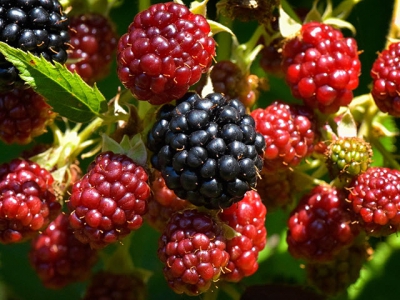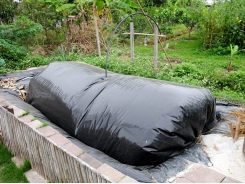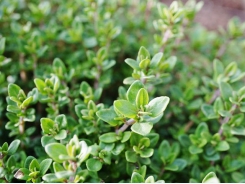Ask Modern Farmer: How Long Do Fruiting Plants Live?

Dear Modern Farmer, I’m thinking about planting blackberry bushes in my yard, and it’s got me curious about the longevity and lifespan of fruit plants. What are some other fruit trees, shrubs, or vines that I can plant, and how long can I expect them to bear fruit? Thanks!
Blackberries cam thrive for a decade if properly taken care of which mostly means regularly thinning and trellising the canes.By Weblogiq / shutterstock
The beautiful thing about fruit plants? Unlike most vegetables, you don’t have to replant each year. However, the lifespan of a fruit tree or bush varies dramatically across varieties. Some olive trees produce copious crops after thousands of years, for example, while strawberries produce for just a few seasons.
Wondering what to expect from a fruit tree, shrub, vine, or perennial that you’re planting this season? Here’s a list of the typical lifespan of 20 common fruits below. And because plants, just like people, live longest when they are healthy, we’ve included a few tips on how to enhance the longevity of each.
Apple | 10-100 years*
Fireblight, an incurable, highly contagious fungal disease, is one thing that can easily curtail the life of these long-lived trees. Always disinfect pruning implements before trimming apples to avoid introducing this pathogen.
Apricot | 10-30 years*
Apricot trees are extremely susceptible to fungal pathogens when grown in a poorly drained location. If planting in heavy clay, improve the drainage by sculpting the soil into a broad, gently tapered mound that rises about 12 inches above the surrounding grade.
Asian Persimmon | 30-50 years
These trees are sensitive to the proper nutrient balance in the soil. It’s best to keep nitrogen fertilizer to a minimum. And in soils with high pH, persimmons tend to develop an iron deficiency, which results in yellow leaves with green veins, a condition known as chlorosis. If this occurs, treat the soil with an acidifying agent (such as sulfur) or fertilize with iron chelate.
Blackberry | 5-10 years
These brambles quickly grow into an impenetrable thicket, which prevents good airflow the natural remedy for the fungal pathogens that blackberries are susceptible to. Thin, prune, and trellis the canes on an annual basis to maintain good health.
Blueberry | 30-50 years
Blueberries thrive in cool, moist acidic soil with lots of organic matter. To ensure a long life, mix equal parts peat and compost with the planting soil and maintain a six-inch layer of mulch around the shrubs at all times.
Cherry | 10-25 years*
Cherry trees are extremely susceptible to fungal pathogens when grown in a poorly drained location. If planting in heavy clay, improve the drainage by sculpting the soil into a broad, gently tapered mound that rises about 12 inches above the surrounding grade
Citrus | 40-80 years
In temperate climates, the single biggest threat to citrus is cold weather. Any time temperatures threaten to dip below 40 degrees, citrus trees must be protected. If such weather is a rarity where you live, simply cover the trees with a tarp on the occasional cold night. Otherwise, plant citrus in large tubs so they can be moved indoors to a sunny window during the winter months.
Currant | 10-20 years
These shrubs hail from northern forests, which means hot, dry conditions are their death knell. Unless you live at a high latitude or elevation, or in a cool coastal climate, plant currants in a location with afternoon shade.
Fig | 30-50 years
Fig trees live longest when their roots have the opportunity to dry out a bit between waterings. Mixing sand into the planting soil and sculpting it into slight mound is an easy way to achieve this in high rainfall areas or where drainage is poor.
Fuzzy Kiwi | 50-70 years
These vines are fairly robust and trouble-free if planted in their preferred climate. They do not tolerate cold winters, nor high humidity, which means the West Coast is primarily where they thrive. If planted elsewhere, they don’t tend to last long.
Gooseberry | 10-20 years
These shrubs hail from northern forests, which means hot, dry conditions are their death knell. Unless you live at a high latitude or elevation, or in a cool coastal climate, plant gooseberries in a location with afternoon shade.
Grape | 50-100 years
Grape vines live longest when their roots have the opportunity to dry out a bit between waterings. Mixing sand into the planting soil and sculpting it into slight mound is an easy way to achieve this in high rainfall areas or where drainage is poor.
Mulberry | 40-60 years
These robust trees rarely fail to thrive, though they are a favorite target of deer during the sapling stage. If deer are prevalent in your area, be sure to fence off your mulberry trees until they are at least 10 feet tall.
Nectarine | 10-25 years*
Nectarine trees are extremely susceptible to fungal pathogens when grown in a poorly drained location. If planting in heavy clay, improve the drainage by sculpting the soil into a broad, gently tapered mound that rises about 12 inches above the surrounding grade.
Olive | 100+ years
Olive trees live longest when their roots have the opportunity to dry out a bit between waterings. Mixing sand into the planting soil and sculpting it into slight mound is an easy way to achieve this in high rainfall areas or where drainage is poor.
Peach | 10-25 years*
Peach trees are extremely susceptible to fungal pathogens when grown in a poorly drained location. If planting in heavy clay, improve the drainage by sculpting the soil into a broad, gently tapered mound that rises about 12 inches above the surrounding grade.
Pear | 10-100 years*
Fireblight, an incurable, highly contagious fungal disease, is one thing that can easily curtail the life of these long-lived trees. Always disinfect pruning implements before trimming pears to avoid introducing this pathogen.
Plum | 10-25 years*
Plum trees are extremely susceptible to fungal pathogens when grown in a poorly drained location. If planting in heavy clay, improve the drainage by sculpting the soil into a broad, gently tapered mound that rises about 12 inches above the surrounding grade.
Pomegranate | 20-30 years
Pomegranate trees live longest when their roots have the opportunity to dry out a bit between waterings. Mixing sand into the planting soil and sculpting it into slight mound is an easy way to achieve this in high rainfall areas or where drainage is poor.
Quince | 10-100 years*
Fireblight, an incurable, highly contagious fungal disease, is one thing that can easily curtail the life of these long-lived trees. Always disinfect pruning implements before trimming quince to avoid introducing this pathogen.
Raspberry | 5-10 years
These brambles quickly grow into an impenetrable thicket, which prevents good airflow the natural remedy for the fungal pathogens that raspberries are susceptible to. Thin, prune, and trellis the canes on an annual basis to maintain good health.
Strawberry | 3-4 years
This groundcover quickly grows into a dense mat, which prevents good airflow the natural remedy for the fungal pathogens that strawberries are susceptible to. Thin the plants to one per square foot on an annual basis to maintain good health.
*The lower end of the range for these plants applies to dwarf varieties; the middle to semi-dwarf varieties; and the top to full-size varieties.
Related news
Tools

Phối trộn thức ăn chăn nuôi

Pha dung dịch thủy canh

Định mức cho tôm ăn

Phối trộn phân bón NPK

Xác định tỷ lệ tôm sống

Chuyển đổi đơn vị phân bón

Xác định công suất sục khí

Chuyển đổi đơn vị tôm

Tính diện tích nhà kính

Tính thể tích ao




 Watermelons get cute
Watermelons get cute  Natural Remedies: 8 Plants That Promote Wellness
Natural Remedies: 8 Plants That Promote Wellness